
Many of the Tudor Society members will be at MadeGlobal’s “An Evening with the Authors” event on 24 September in central London, and it would be so lovely to see you there.
[Read More...]
Many of the Tudor Society members will be at MadeGlobal’s “An Evening with the Authors” event on 24 September in central London, and it would be so lovely to see you there.
[Read More...]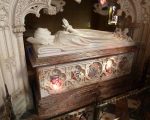
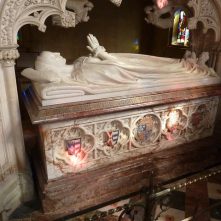
Catherine Parr's tomb
1548 - Catherine Parr, Queen Dowager, wife of Thomas Seymour and widow of Henry VIII, died aged around 36 at Sudeley Castle. She had given birth to her first child, a daughter Mary, on 30th August, but within a few days of the birth, she had contracted puerperal fever. You can read an article about her burial on the Anne Boleyn Files - click here - and you can read Catherine Parr related articles on the Tudor Society by clicking here.
1558 (5th or 6th September) – Death of Sir Robert Broke, judge, legal writer and Speaker of the House of Commons, at a friend's house in Patshull, Staffordshire. He was buried in Claverley Church, Shropshire. Broke also served as Deputy Chief Steward for the Duchy of Lancaster, Serjeant-at-Law and Chief Justice of the Common Pleas.
1569 – Death of Edmund Bonner, Bishop of London and a man nicknamed “Bloody Bonner”, in Marshalsea Prison. He was buried at St George's, Southwark, but it is thought that his remains were later moved to Copford, near Colchester, a manor held by Bonner as Bishop of London. In Mary I's reign, he was in charge of burning reformers in London, hence his nickname “Bloody Bonner”. Bonner was imprisoned in Elizabeth I's reign for refusing to follow the “Book of Common Prayer” in his services, and for refusing to take the “Oath of Supremacy”.

I quite often receive questions about the dolls I have on my bookcase and Margaret asked if I would do a Claire Chats video on them, explaining how/where I got them. So, here you go! My collection is all down to my dear friend Dawn Hatswell – thank you Dawn!
[Read More...]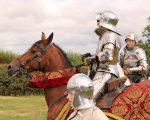
In this series, I have followed the progress of Henry and Jasper Tudor from Pembroke Castle to their long exile in Brittany and their return with an army to Wales. Their long march, covering as much as twenty-six miles a day, ended when they encountered King Richard III’s army camped at Ambion Hill, close to Sutton Cheyney.
The Battle of Bosworth is poorly documented, with no first-hand accounts surviving. Anything we read about the battle, therefore, has to be looked at closely to see who wrote it and when. One of the best summaries of the often conflicting accounts is Chris Skidmore’s book, Bosworth – The Birth of The Tudors. Even as Chris was writing the book, news emerged of a new location for the battlefield site, and the bones of Richard III were discovered in a car park as he completed the first draft.
[Read More...]
On the 10th August 1512, the Battle of Saint-Mathieu, a battle in the War of the League of Cambrai, took place between the English and Franco-Breton fleets off the coast of Brest. England at this time was allied with Spain and the Holy Roman Empire against France.
[Read More...]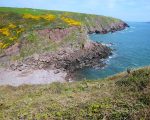
After following the long exile of Jasper and Henry Tudor in Brittany, I have now returned to Pembrokeshire in West Wales. The Tudors had made an unsuccessful attempt to invade England in 1483 but learned from this near disaster. On Monday 1st of August, 1485 they sailed again from the mouth of the Seine with their mercenary army of some four thousand men to challenge King Richard III for the crown.
It seems the sea voyage led by the Poulian De Dieppe, flagship of their capable captain, Guillaume de Casenove, was uneventful and had the benefit of favourable winds. They made landfall at Mill Bay, a secluded, pebble-strewn beach in the far west of Wales just before sunset on Sunday 7th August. It is reported that, on going ashore, Henry Tudor kissed the ground and recited a Psalm in Latin. Some accounts suggest it was Psalm 23, but the consensus was Psalm 46: ‘Judge me, O God, and plead my cause against an ungodly nation: O deliver me from the deceitful and unjust man.’
[Read More...]
In this series, I have followed Jasper Tudor and his nephew Henry’s escape from Tenby in Wales to their long exile in Brittany. Young Henry Tudor found himself deep in the forest at the remote Forteresse de Largoët, outside of the Breton town of Elven. He would have missed the company of his uncle Jasper, who was now in a far grander place, the Château de Josselin.
Originating from the year 1008, the château overlooking the River Oust has changed many times over the centuries. Olivier de Clisson, Constable of France, became Lord of Josselin in 1370 and rebuilt the fortress with eight high towers and married his daughter Beatrice to Viscount Alain de Rohan. During the religious wars of the seventeenth century, Duke Henri de Rohan commanded the Calvinists and his château was sacked by Cardinal de Richelieu. Only four of the original towers remain today, but the château is still home to the fourteenth Duke Josselin de Rohan.
[Read More...]
In the first two parts of this series, I followed Jasper Tudor and his fourteen-year-old nephew Henry’s escape from Tenby in Wales and their arrival in Brittany. The Tudors are recorded as spending a year in Vannes as guests of Duke Francis of Brittany but, in October 1472, the duke became concerned they might be abducted by York’s agents. They were moved to his remote ‘hunting lodge’ by the sea, south of Vannes, the Château de Suscinio.
The Tudors’ new home had been fortified in the fourteenth century by Breton knight Bertrand du Guesclin, nicknamed ‘The Eagle of Brittany’, a military commander during the Hundred Years’ War. As well as building the seigniorial residence block and a corner tower known as the Tour Neuve, the moat was deepened and a raising drawbridge added, together with casemates to house artillery. By the time the Tudors arrived, the original thirteenth century château resembled a castle of generous proportions.
[Read More...]
In the first part of this series, I followed Jasper Tudor and his young nephew Henry’s escape from Tenby in West Wales. There are tales of storms and of them being forced to shelter in the lee of the island of Jersey before they were able to make landfall at the Breton fishing port of Le Conquet in September 1471.
Jasper and Henry sought sanctuary from Duke Francis of Brittany and became his guests at the ducal palace, the Château de l’Hermine in Vannes. Duke Francis was a skilled politician, so would have appreciated the political value of the exiled Tudors to King Edward IV of England, as well as to his rival King Louis of France, to whom they were related through the Valois family of Jasper’s mother, Henry’s grandmother, Queen Catherine.
[Read More...]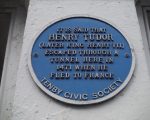
Henry Tudor’s return from exile to victory at Bosworth has to be one of the greatest moments in the history of the Tudor dynasty. So why is the Bosworth story so often told from the perspective of Richard III, with Henry depicted as lucky to have won?
I was born within sight of Pembroke Castle and have always been intrigued by the small room where the thirteen-year-old Lady Margaret Beaufort gave birth to the future king, Henry Tudor. I’ve also stood on the remote beach at Mill Bay near Milford Haven imagining how Henry would have felt as he approached with his uncle Jasper and his mercenary army.
All I knew about Jasper’s father, Henry’s grandfather, Owen Tudor, was that he’d been a Welsh servant who somehow married the young widow of King Henry V, Queen Catherine of Valois. Inspired to write a historical fiction trilogy about them, I wanted to research their stories in as much detail as possible and to sort out the many myths from the facts.
[Read More...]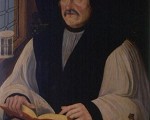
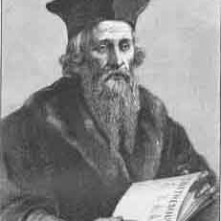 1534 – Germain Gardiner wrote a tract against reformer and martyr John Frith entitled “A letter of a yonge gentylman named mayster German Gardynare, wherein men may se the demeanour and heresy of John Fryth late burned”.
1534 – Germain Gardiner wrote a tract against reformer and martyr John Frith entitled “A letter of a yonge gentylman named mayster German Gardynare, wherein men may se the demeanour and heresy of John Fryth late burned”.
1545 – Birth of Andrew Melville, Scottish theologian and Principal of St Mary's College, St Andrews University, at Baldovy, Angus.
1555 - Apothecary, alchemist and medium Sir Edward Kelley was born on this day in 1555 in Worcester. Click here to read about Kelley.
1556 – Burning of Joan Waste, a blind woman, in Derby for heresy after she refused to recant her Protestant faith.
1596 – Death of John Astley (Ashley), courtier, probably at Maidstone in Kent. He was buried there at All Saints' Church. Astley served Elizabeth I as a Gentleman of the Privy Chamber, Master of the Jewel House and Treasurer of the Queen's Jewels and Plate. He was also married to Katherine Astley (née Champernowne), Elizabeth I's former governess and Chief Gentlewoman of the Privy Chamber.
1605 – Death of Sir Edmund Anderson, Judge and Chief Justice in Elizabeth I's reign, in London. He was buried in the parish church at Eyworth.
1514 – Edward Stafford, Duke of Buckingham, was granted a licence to found a college at Thornbury.
1521 – Cardinal Wolsey arrived in Calais to act as peacemaker and preside over a conference aiming to put an end to the fighting between France and the Empire.
1553 – Elizabeth greeted her half-sister, the newly proclaimed Queen Mary I, in London.
1555 – Burning of James Abbes, Protestant martyr, in Bury for heresy.
1556 – Death of George Day, Bishop of Chichester. He was buried in Chichester Cathedral.
1581 – Burning of Richard Atkins, Protestant martyr, before St Peter's in Rome. It is said that as he was taken to St Peter's, his back and breast were burned by men holding torches, and that his right hand was then cut off and his legs burned first to prolong his suffering.
1589 – Death of Henry III of France after being stabbed in the abdomen by Jacques Clément, a fanatical Dominican friar, the day before. He was buried at the Basilica of Saint-Denis.
1595 – The Battle of Cornwall. Spanish forces landed at Mount's Bay and the English militia fled, allowing the Spanish troops to move on and burn Penzance, Mousehole, Paul and Newlyn. Click here to read more.
1596 – Burial of Thomas Whithorne, composer and autobiographer, at St Mary Abchurch, London. Whithorne was Chapel Master to Archbishop Matthew Parker.
1601 – Death of George Eyste, author, town lecturer, preacher and Vicar. He died in Bury St Edmunds, Suffolk, and was buried in his church, the Church of St Mary.
1605 – Death of Vice Admiral Sir Richard Leveson in the Strand, London. He was buried in St Peter's Church, Wolverhampton.
1528 – Death of Hugh Inge, Archbishop of Dublin and Lord Chancellor of Ireland, from sweating sickness in Dublin. He was buried in St Patrick's Cathedral, Dublin.
1548 – Birth of Sir Robert Houghton, judge, Treasurer (1599) and Sergeant-at-Law (1603), in Gunthorpe, Norfolk.
1549 – Lord Russell marched his 1000 men from Honiton to Woodbury and set up camp for the night. He was heading towards Clyst St Mary and the rebels of the Prayer Book Rebellion.
1553 - Mary, who had just been proclaimed Queen Mary I, rode with her half-sister, Elizabeth, from Wanstead to Aldgate to be greeted by the city as its new Queen.
1557 - The body of forty-one year-old Anne of Cleves, fourth wife of Henry VIII, was processed from her home, Chelsea Old Manor, where she had died on 16th July, to Westminster Abbey for burial.
1558 – Burial of Thomas Alleyne, clergyman and benefactor, at St Nicholas Parish Church, Stevenage. Alleyne was known for his support of education, through his financing of schoolmasters and the free tuition he arranged for boys.
1562 – Death of John de Vere, 16th Earl of Oxford, leading magnate in Essex and notorious rake, at Hedingham Castle in Essex.
1540 - Brother William Horne, laybrother of the London Charterhouse was hanged, disembowelled and quartered at Tyburn. He was the last of the Carthusian martyrs to be killed after eighteen members of the Carthusian order of monks based at the London Charterhouse were condemned to death in 1535 for refusing to accept King Henry VIII as the Supreme Head of the Church.
1549 – The Battle of Woodbury Common, part of the Prayer Book Rebellion. The battle took place at 4am and happened when the rebels, who had been defending Clyst St Mary, marched to Woodbury Mill where Lord Russell and his troops had camped for the night. The rebels were defeated. Click here to read more.
1557 – Burial of Anne of Cleves, fourth wife of Henry VIII, at Westminster Abbey.
1560 – Baptism of Sir John Harington, courtier, translator and author, in the church of All Hallows, London Wall. His godparents were Elizabeth I and William Herbert, 2nd Earl of Pembroke. In his “New Discourse of a Stale Subject, called the Metamorphosis of Ajax” (1596), Harington outlined his design for a flush toilet – a privy with a cistern and flush valve. The Ajax, as it was called, was eventually installed at Richmond Palace. See Sir John Harington's Flush Toilet.
1566 – Death of Sir Martin Bowes, goldsmith, politician, Lord Mayor of London and Under- Treasurer of the Royal Mint in the Tower of London. He was buried at St Mary Woolnoth, Lombard Street, London.
1578 – Death of soldier Thomas Stucley at the Battle of Alcazar. Stucley was fighting against the Moors, with King Sebastian of Portugal, when his legs were blown off by a cannon shot.
1598 - William Cecil, 1st Baron Burghley, died at his home in London aged seventy-six. He was laid to rest at St Martin's Church, Stamford, in his home county of Lincolnshire.
1612 – Death of Hugh Broughton, scholar, theologian and Hebraist, in Cheapside, London. He was buried at St Antholin's Church. Broughton spent the last twenty years of his life petitioning for a new translation of the Bible. His works included “A Concent of Scripture” (1588), “An Epistle to the learned Nobilitie of England, touching translating the Bible from the Original” (1597) and “An Advertisement of Corruption in our Handling of Religion” (1604).
1503 – Death of Sir Reynold (Reginald) Bray, administrator in the reign of Henry VII. He served the King as Chancellor of the duchy of Lancaster, Treasurer of England and Treasurer for war. Some say that he was an architect and designed Henry VII's Chapel in Westminster Abbey, St George's Chapel in Windsor Castle, where he is buried, and Great Malvern Priory. He definitely funded their building.
1532 – Death of Sir Nicholas Harvey, diplomat, at Ampthill, Bedfordshire. He was buried in Ampthill Church where his memorial brass can still be seen.
1549 – The Battle of Clyst St Mary during the Prayer Book Rebellion. The Devonian and Cornish rebels were defeated by Lord Russell's troops, and around 900 prisoners were massacred later that day on Clyst Heath. Click here to read more.
1551(5th or 6th August) – Death of Henry Holbeach, Bishop of Lincoln, at Nettleham.
1600 – Deaths of John Ruthven, 3rd Earl of Gowrie, and his brother, Alexander Ruthven, Master of Ruthven, at Gowrie House near Perth. The brothers were killed as they tried to kidnap James VI. They were posthumously found guilty of treason on 15th November 1600 and their bodies hanged, drawn and quartered in Edinburgh.
1601 – Burial of Henry Norris, 1st Baron Norris of Rycote, courtier, diplomat and son of Sir Henry Norris, one of the men executed for alleged adultery with Queen Anne Boleyn. Norris was buried at the chapel at Rycote in Oxfordshire.
1504 – Birth of Matthew Parker, Archbishop of Canterbury, in the parish of St Saviour, Norwich. Parker was the son of worsted weaver William Parker and his wife Alice Monings [Monins] from Kent.
1514 – Marriage of Margaret Tudor, sister of Henry VIII and widow of James IV of Scotland, and Archibald Douglas, 6th Earl of Angus, at Kinnoull in Perthshire.
1549 – Battle of Clyst Heath during the Prayer Book Rebellion. Click here to read more.
1623 – Death of Anne Hathaway, wife of William Shakespeare. Anne was buried next to her husband in the Church of the Holy Trinity, Stratford-upon-Avon.
1485 – Henry Tudor (future Henry VII) dropped anchor at Mill Bay, Milford Haven, Wales. When he reached the beach, it is said that he prayed “Judge me, O Lord, and favour my cause.”. He had returned from exile to claim the crown of England.1514 – Peace treaty signed between England and France, arranging the marriage of the widowed fifty-two year old Louis XII of France and the eighteen year-old Princess Mary Tudor, sister of Henry VIII.
1541 – Death of Sir Richard Weston, courtier and father of Sir Francis Weston who was executed in 1536 for alleged adultery with Queen Anne Boleyn. Richard served Henry VII as Groom of the Chamber and Henry VIII as an Esquire of the Body, Governor of Guernsey and treasurer of Calais. He was buried in Holy Trinity Church, Guildford.
1549 – The five year-old Mary, Queen of Scots set sail from Dumbarton, Scotland, for France. A marriage had been agreed between Mary and Francis, the Dauphin, so Mary was going to be brought up at the French court. Mary arrived at Saint-Pol-de-Léon, near Roscoff in Brittany, just over a week later.
1574 - Sir Robert Dudley, mariner, cartographer and landowner, was born on this day in 1574 at Sheen House, Richmond. He was the illegitimate son of Robert Dudley, Earl of Leicester and favourite of Elizabeth I, and his lover Lady Douglas Sheffield, daughter of William Howard, 1st Baron Howard of Effingham, and widow of John Sheffield, 2nd Baron Sheffield.
1600 – Burial of Sir Thomas Lucy in the parish church at Charlecote, Warwickshire. Lucy was a magistrate and member of Parliament, but is best known for his links with William Shakespeare. Tradition has it that Shakespeare wrote a satirical ballad about Lucy, or he made a caricature of him in the character of Judge Shallow, as revenge after he was judged too harshly for poaching on Lucy's estate, Charlecote Park. There is no evidence to support this story.
1613 – Death of Sir Thomas Fleming, Solicitor-General to Elizabeth I and James I, at Stoneham Park. He also served James I as Chief Justice of the King's Bench. He was buried at North Stoneham Church.

As part of this month’s Mary Rose feature, with our guest speaker Philip Roberts (author of “The Mary Rose in a Nutshell), we have this wonderful video showing some behind-the-scenes footage of the ship and its treasure trove of finds.
[Read More...]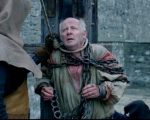
On this day in history, 12th July 1537, Robert Aske, lawyer and rebel, was hanged in chains outside Clifford’s Tower, the keep of York Castle. Aske was one of the leaders of the rebels in the 1536 northern uprising known as the Pilgrimage of Grace – click here to see a Pilgrimage of Grace timeline and here to read an article on the rebellion.
Being hanged in chains was an awful way to die. Those executed this way were usually hanged alive in chains – rather than being hanged first in the usual manner and then put in chains on display – and took several days to die, being slowly suffocated to death. Horrible!
[Read More...]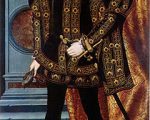
On this day in 1543, the Treaties of Greenwich were signed. In these treaties between England and Scotland, it was agreed that Prince Edward, the future Edward VI, would marry Mary, Queen of Scots.
[Read More...]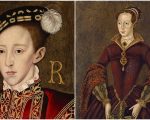
On 21st June 1553, letters patent were issued stating that King Edward VI’s heir was Lady Jane Grey, eldest daughter of the king’s cousin, Frances Brandon, Duchess of Suffolk.
Edward VI was dying, having been ill for a few months, and in the original draft of his “Devise for the Succession” he stipulated that the Crown would descend through the male heirs of Frances, Duchess of Suffolk, if Edward died childless. The problem was that there were no male heirs yet, so when Edward made a turn for the worse he decided to change the document to read: “To the Lady Fraunceses heirs males, if she have any such issue before my death to the Lady Jane and her heirs males.”
[Read More...]
The four weeks of Advent began on Advent Sunday, the fourth Sunday before the Nativity, and was a time of fasting, i.e. abstaining from meat. Christmas Eve was even stricter than the rest of advent, with no meat, cheese or eggs being eaten, until after midnight mass when it was officially Christmas Day.
[Read More...]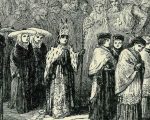
The 6th December was and is the feast of St Nicholas, or St Nicholas of Myra, the 4th century Bishop of Myra (modern-day Demre in Turkey), who is the patron saint of children, as well as sailors, merchants, archers, repentant thieves, brewers, pawnbrokers and students. In medieval and Tudor times, it was traditional for a choirboy to be chosen on 6th December or Childermas (Holy Innocents’ Day) as “Boy Bishop” to act as bishop and to lead processions around communities, collecting money for the church and parish funds, and to lead some religious services.
[Read More...]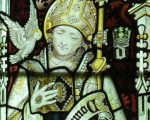
1st March is the feast day of St David (Dewi Sant), patron saint of Wales. According to Rhigyfarch’s Life of Saint David, David lived in the 6th century and founded religious centres including Glastonbury and Croyland. He then travelled to the Holy Land and was made archbishop at Jerusalem before travelling back to Wales and settling at Glyn Rhosyn (Rose Vale), or St David’s, in Pembrokeshire, Wales. There, he founded a monastery whose site is now marked by St David’s Cathedral.
[Read More...]